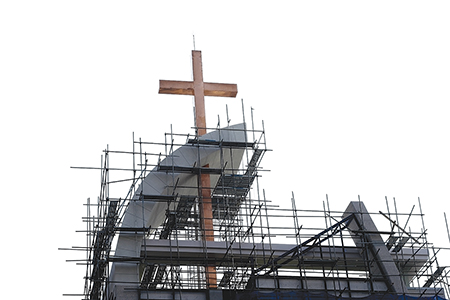By Dan Mikes
Lender experience — and your preparation — are keys to success
![]() A true ministry banker understands that business administrators at religious institutions might only undertake a major commercial construction project once or twice in their careers.
A true ministry banker understands that business administrators at religious institutions might only undertake a major commercial construction project once or twice in their careers.
A lender with specialized expertise in financing religious institutions will not expect you to intimately understand or fully anticipate the commercial construction and related borrowing processes. Rather, a lender with a depth of experience banking this segment can provide consultation and guide you through the process.
Nevertheless, the ministry will be best served when adequately prepared about what to expect.
To assure that your lender selection process goes as smoothly as possible, start by looking for lenders with an established track record of working with religious institutions. Good indications that lenders have a focused commitment to the religious segment include: a long history of providing loans and banking services to religious institutions; full-time designated staff with a depth of religious banking experience; specific mention of religious institution lending on the lender’s website; ministry-specific marketing brochures and support materials; and, of course, a long list of religious institutions references.
 An experienced lender can help your religious institution identify its borrowing capacity when planning a construction project. It is most beneficial to seek this consultation in advance of working with your architect to develop a design concept. Be prepared to share the details of any pending capital pledge campaign, such as the campaign start date, target total pledge goal and desired construction start date.
An experienced lender can help your religious institution identify its borrowing capacity when planning a construction project. It is most beneficial to seek this consultation in advance of working with your architect to develop a design concept. Be prepared to share the details of any pending capital pledge campaign, such as the campaign start date, target total pledge goal and desired construction start date.
One of the more common mistakes religious institutions make is not allowing enough time between submitting loan applications to lenders and the desired project start date. First, your religious institutions should allow 30 days to submit loan applications and receive financing offers.
Once offers are in hand, your leadership team should make a final lender selection 90 days prior to the desired project start date. Normally, a construction loan can be closed within 60 days. By allowing 90 days, you will have time to work through any unanticipated issues related to “clouds” on land title (old unreleased mortgages, easements) or environmental issues. No matter what, never start construction before you have a firm financing commitment in hand, with all contingencies met (appraisal, environmental and so on). Aside from the matter of “broken lien priority” — which could complicate your ability to secure title insurance (a standard loan requirement) — you also risk your credibility with potential lenders. Lenders might question why you would put your institution’s good name on a construction contract prior to securing the means to meet the financial obligations under that contract.

Given your financing offer will be contingent upon a maximum loan-to-value, your property value and proposed improvements will need to be appraised. Consequently, your religious institutions will also need to coordinate the timeline for the development of the architectural plans and a line-item construction budget. These generally need to be at least 75-percent complete at the time of lender selection for the lender to order your appraisal. The appraisal can take from four to six weeks to complete. Additionally, your lender might require that a cost engineer be engaged to review the construction plan and budget. The cost review can usually be completed within two or three weeks, assuming the architectural plans and budget are 95-percent complete upon submission to the engineer.
As you near loan closing, you will need to provide the lender with comprehensive lists of the “Sources and Uses” of funding. Both these dollar amount totals must match as of loan closing. The “sources” list should only include three items: costs already paid prior to loan closing; cash on hand for the project; and amount of loan commitment.
Some borrowers mistakenly include a fourth source: future cash from incoming pledges during construction. Most lenders will not want to assume the risk of liens or even litigation, which could arise should unforeseen economic or other events cause the pledge campaign to stall out after the loan is closed. The total “uses-of-funds” list is not limited to the construction contract amount. The “uses” list must also include other project-related costs, such as architectural fees, permits, soil tests, landscaping, off-site items (turning lanes or street lights, for example), loan closing costs and so on.
Loan covenants typically prohibit unilateral execution of change orders without prior written authorization from the lender. In some cases, lenders might approve release of a portion of the amount budgeted for “contingency” as the means of funding a change order. When considering releasing contingency, one point-of-focus for the lender will be the percent-of-project-completed-to-date. Generally speaking, lenders prefer the percent-of-contingency-released-to-date to remain within proximity of the percent-of-project-completed. Consequently, a bank will be less likely to release a significant amount of the contingency early in the project cycle.
A well-planned project timeline and a thoughtfully managed financing process can be achieved when you seek the safety of the right lender. Your prospects of achieving this outcome increase when you begin by contacting an experienced religious institutions lender early in the process. A major commercial construction project is not a simple undertaking, and there is no point in making it more complicated by having to school your lender on all things religious institutions-specific.
Dan Mikes is Executive Vice President and National Manager of the Religious Institution Division, Bank of the West, in San Ramon, CA.


